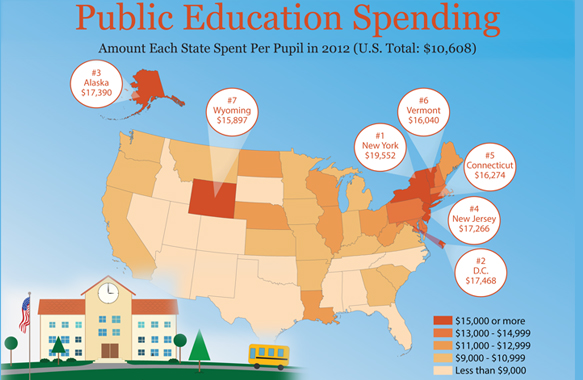For the First Time, Public Education Revenue Decreases in 2012, Census Bureau Reports
Originally Published at United States Census Bureau.

Public elementary and secondary education revenue declined in fiscal year 2012 for the first time since 1977, when the U.S. Census Bureau began collecting public education finance data on an annual basis. According to new Census Bureau findings released today, public elementary and secondary school systems received $594.5 billion in total revenue in fiscal year 2012, down $4.9 billion (0.8 percent) from fiscal year 2011.
Today’s findings come from Public Education Finances: 2012. These statistics provide figures on revenues, expenditures, debt and assets (cash and security holdings) of the nation’s elementary and secondary public school systems. The report, released annually, includes detailed statistics on spending — such as instruction, student transportation, salaries and employee benefits — at the national, state and school district levels.
State governments were the leading source of revenue ($270.4 billion), closely followed by revenue from local sources ($264.6 billion); almost two-thirds (65.3 percent) of revenue from local sources came from property taxes. Public school systems received $59.5 billion in revenue from the federal government, a decrease of $14.2 billion (19.2 percent) from the previous fiscal year.
The 50 states and the District of Columbia spent $10,608 per student on public elementary and secondary education in 2012, the same amount as 2011. All nine states in the Northeast were ranked among the 15 states with the highest spending per pupil (not including capital outlay or expenditure on long-term debt) in 2012. Out of the 20 states with the lowest spending per pupil, 18 were in the South or West.
The top spenders per pupil were New York ($19,552), the District of Columbia ($17,468), Alaska ($17,390), New Jersey ($17,266) and Connecticut ($16,274).
For the third year in a row there was a decline in total expenditures, which decreased to $593.8 billion, a $2.5 billion (0.4 percent) decrease from the previous year.
For the first time, these statistics can be found in American FactFinder, one of the Census Bureau’s data research tools.
Other highlights:
